While most people spend countless hours in the gym performing squats, lunges, deadlifts, and planks to strengthen their sagittal and frontal plane muscles (Fig. 1), relatively few focus on the small but extremely important transverse plane stabilizing muscles. This is unfortunate because these key muscles fine-tune joint positions so the large prime movers can function efficiently, and they offload neighboring ligaments, making them essential for injury prevention. One of the most important transverse plane muscles is the popliteus. Often referred to as “the key to the knee,” this muscle runs from the upper outer aspect of the femur and inserts along the inner side of the upper tibia. Because popliteus traverses the back of the knee at a 45° angle, it has the unique ability to stabilize the knee against twisting actions. As illustrated in figure 2, whenever the upper body and thigh are rotating in one direction, the knee would be subjected to a potentially damaging rotational strain if the popliteus did not contract to stabilize the knee joint. By limiting twisting at the knee, the popliteus muscle plays a significant role in protecting the joint capsule, the collateral ligaments, and the cruciate ligaments.
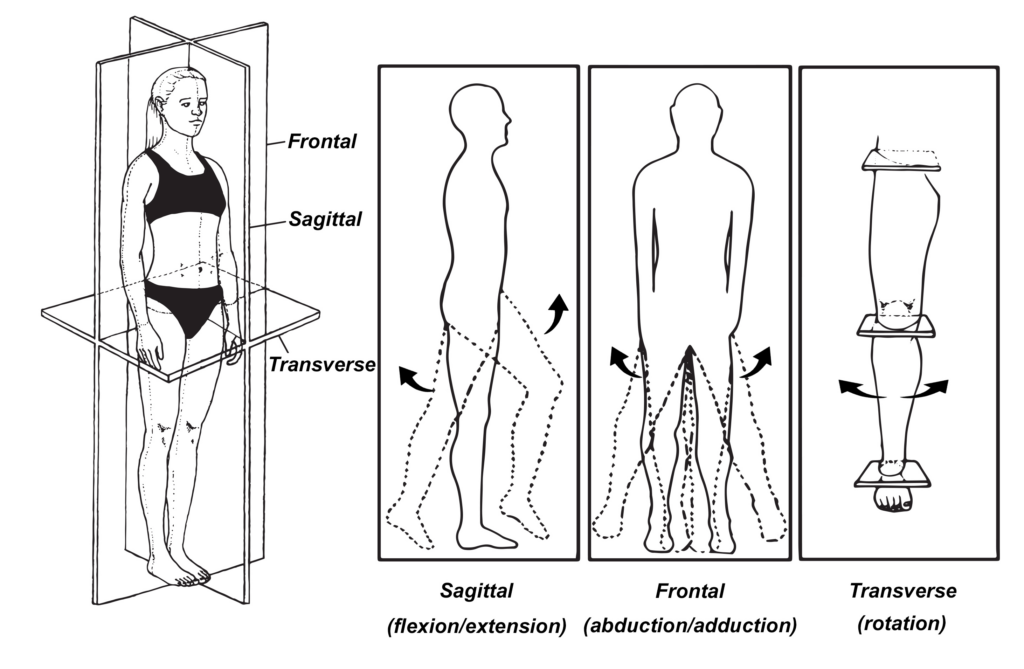
Fig. 1. In order to describe motion, the body is divided into 3 reference planes. The body’s largest and most powerful muscles (e.g., glutes hamstring, quads, and ankle plantarflexors) function primarily in the sagittal plane. Other large muscle such as the hip abductors and adductors function in the frontal plane. Although rarely discussed, there is an important group of stabilizing muscles that function in the transverse plane, the most important of which are the hip rotators, popliteus, and tibialis posterior.
Fig. 2. The popliteus muscle. Because this muscle traverses the back of the knee, it plays an important role in preventing knee injury by limiting transverse plane rotation. In this illustration, extension of the kicking leg (A) internally rotates the weight-bearing femur (B), which in turn creates a twisting force at the knee (C) as the tibia is maintained in a fixed position due to ground contact. The degree of twisting between the femur and tibia is primarily controlled by popliteus (D).
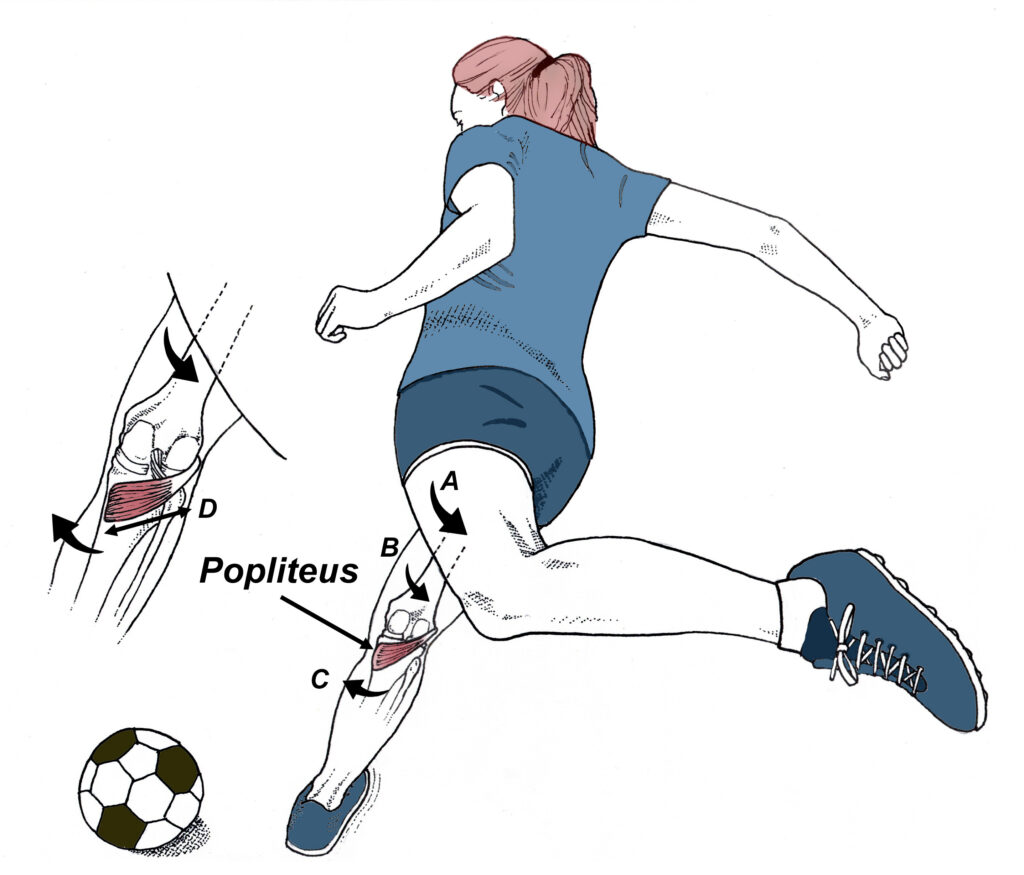
Another significant transverse plane stabilizer that protects the knee is the semimembranosus muscle. Although the upper fibers of semimembranosus function with the rest of the hamstring muscles to control sagittal plane motion in the hip, the lower fibers play a significant role in protecting the medial meniscus from injury. Because the lower portion of semimembranosus has a firm attachment to the medial meniscus, it is able to pull the medial meniscus posteriorly as the knee flexes, which prevents the posterior horn of the medial meniscus from being torn when the knee flexes rapidly (1) (Fig. 3). The lower fibers of semimembranosus work hand-in-hand with the popliteus muscles to control rotational movements at the knee. Precise control of rotational movements between the tibia and femur is necessary to prevent horizontal tears of the menisci, which occur when the femur twists excessively on the tibia. Unlike large radial or bucket handle tears that occur in high-impact sports, horizontal tears of the menisci are almost always the result of age-related wear and tear and respond extremely well to semimembranosus and popliteus strengthening exercises. Horizontal tears of the menisci are especially common in older athletes, particularly ones involved in twisting sports like tennis, soccer, and basketball. Unfortunately, rotational exercises are rarely incorporated in the management of this common injury.
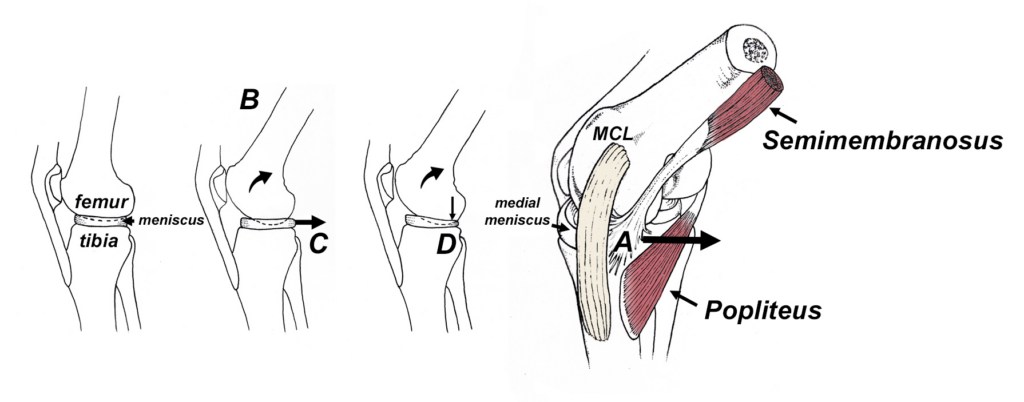
Fig. 3. Because the lower branches of semimembranosus blend in with the medial meniscus (A), contraction of this important hamstring muscle displaces the medial meniscus posteriorly (arrow), which in turn protects the posterior medial meniscus from impingement during knee flexion. As illustrated on the left, as the knee flexes (B) semimembranosus pulls the medial meniscus posteriorly (C) allowing the round femoral condyle to be safely situated deep in the socket created by the medial meniscus. In contrast, failure of semimembranosus to pull the meniscus posteriorly allows the round femoral condyle to roll back on the flat tibial plateau, pinching the posterior aspect of the meniscus (D). Syms et al. (1) state that semimembranosus produces a “dynamizing effect that tightens the posteromedial structures at a time when they would normally be lax and at the same time helps to prevent posteromedial meniscal impingement during knee flexion.” Abbreviations: MCL= medial collateral ligament.
Transverse plane exercises are also essential for exercising the most important stabilizer of the foot and ankle: tibialis posterior (Fig. 4). Although numerous exercise protocols have been recommended to strengthen this muscle, a detailed pre- and post-MRI study of tibialis posterior activity associated with specific exercises confirms that resisted forefoot adduction produces the greatest increase in activity. In fact, compared to conventional heel raise exercises, resisted forefoot adduction produced almost twice as much activity in the tibialis posterior muscle (2). Transverse plane exercises of the ankle are also a great way to strengthen the peroneus brevis muscle, which helps to prevent lateral ankle sprains.
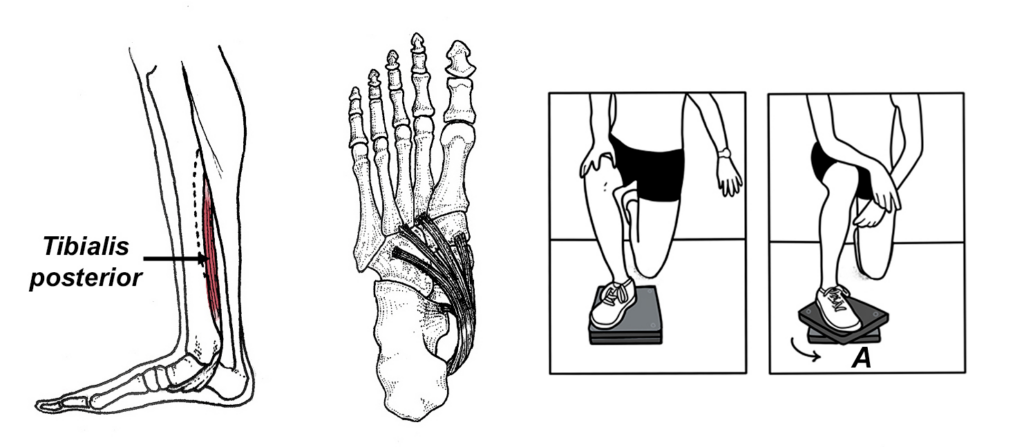
Fig. 4. Tibialis Posterior. This muscle originates on the back of the leg and runs behind the inner ankle attaching at multiple points in the center of the arch. Tibialis posterior is far and away the most important stabilizer of the medial longitudinal arch. Research shows that exercising tibialis posterior in the transverse plane (A) is nearly twice as effective as conventional heel raise exercises.
Perhaps the most significant transverse plane stabilizers of the lower extremity are in the hip (Fig. 5). A growing body of research confirms that these small but powerful muscles play an underappreciated role in preventing injuries throughout the entire lower extremity. Early research showed that weakness of the hip rotators correlated strongly with foot and ankle injuries (3), while more recent research shows that hip rotator weakness is one of the single best predictors of ACL tears in athletes (4). In fact, a study out of Iran involving over 530 athletes showed that athletes with hip rotator weakness were 7 times more likely to tear their anterior cruciate ligament in a single season. The most likely mechanism is that hip rotator weakness allows the knee to collapse inward, which is a proven predictor of ACL injuries. Hip rotator weakness is especially problematic if combined with semimembranosus weakness, as the semimembranosus is a powerful stabilizer of the anterior cruciate ligament. Additionally, because these muscles reinforce the femoral neck, they help protect against femoral neck stress fractures, and may even help prevent hip fractures associated with lateral falls in the elderly (5) (Fig. 6).
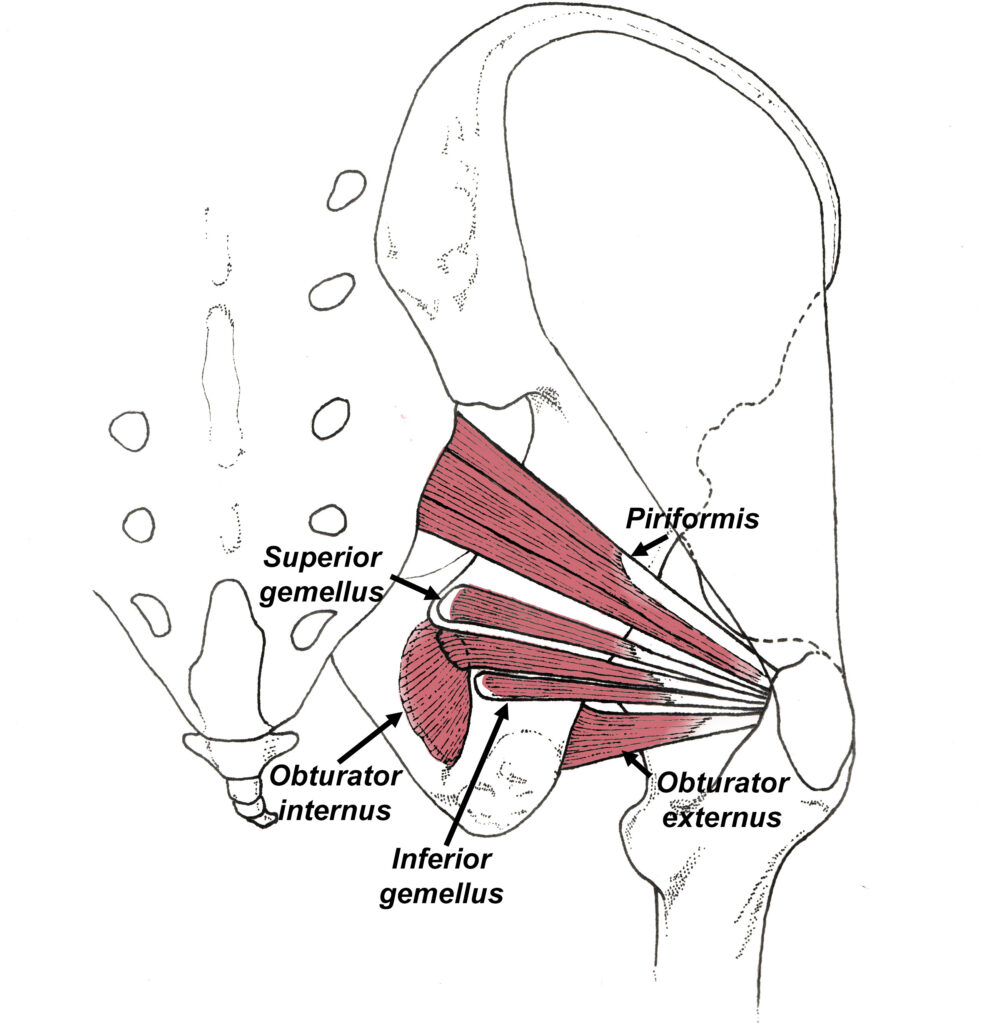
Fig. 5. The external rotators of the hip.
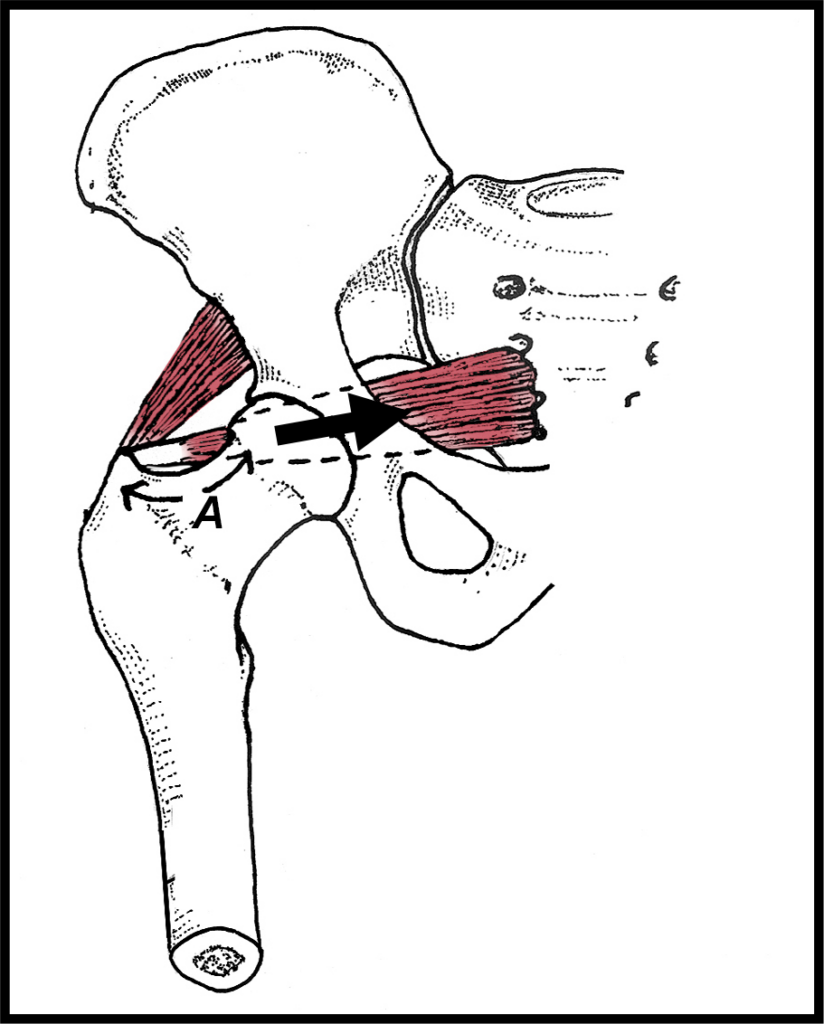
Fig. 6. Contraction of the piriformis muscle creates a strong compressive force (large black arrow) that limits bending forces at the femoral neck (A).
Although there are a wide range of exercises that target each of the transverse plane stabilizers, the easiest way to strengthen all of these muscles simultaneously is with the Twist Disk. This product is comprised of 2 rubber plates that are bolted to a powerful spring-loaded resistance mechanism that provides significant resistance as the disk is rotated. My favorite routine to strengthen all of the transverse plane muscles is to perform one set of 30 repetitions in each of 3 positions illustrated in figure 7. As you get stronger, you may notice that you’re slightly weaker when your knee is flexed at a specific angle; e.g., people with weak popliteus muscles will have difficulty rotating Twist Disk inward when the knee is bent 30°, while people with weak hip rotators will have difficulty rotating Twist Disk outward when their hips and knees are straight. The best way to address isolated weakness is to reproduce the angle you have the most difficulty with and hold an isometric contraction in this position for 30-60 seconds. As you get stronger, you can preload the muscles by rotating the Twist Disk prior to performing the exercise. By rotating the Twist Disk 45° before initiating the exercise, you maximize resistance by rotating the spring at peak tension. It’s easy to tell when the Twist Disk is at peak tension because you’ll hear a slight click at the end range of motion. Regardless of whether you’re an older weekend warrior trying to stay active and avoid being injured or an elite athlete trying to maximize performance, strengthening the transverse plane stabilizers should be an essential part of your exercise routine.
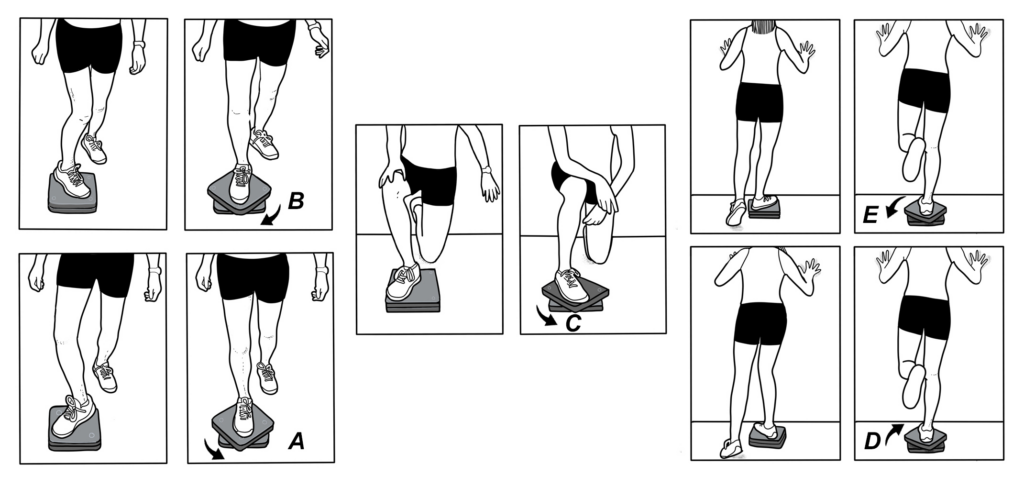
Fig. 7. The Twist Disk Exercise Routine. To strengthen the popliteus (and hip internal rotators), place the Twist Disk on the floor with your knee flexed 30° and twist in from a slight toe out to a neutral foot (A). You can reverse this direction to strengthen the hip external rotators in the lower fibers of the biceps femoris muscle (B). Tibialis posterior is strengthened while kneeling with the knee flexed 90°. Begin with a slight toe out and pull the forefoot inward (C). You can go in the opposite direction to strengthen peroneus brevis. The hip external rotators and core muscles are exercised by leaning against a wall and twisting the straight leg outwardly (D) (starting with your foot rotated in about 45°). The hip internal rotators are strengthened by moving in the exact opposite direction (E).
References:
- Sims W, Jacobson K. The posteromedial corner of the knee. Am J Sports Med. 2004;32:337.
- Kulig K, Burnfield J, Requejo S, et al. Selective activation of tibialis posterior: evaluation by the magnetic resonance imaging. Med Sci Sports Exerc. 2004:867.
- Leetun D, Ireland M, Willson J, et al. Core stability measures as risk factors for lower extremity injury in athletes. Med Sci Sports Exerc. 2004;36:926–934.
- Khayambashi K, Ghoddosi N, Straub R, et al. Hip Muscle Strength Predicts Noncontact Anterior Cruciate Ligament Injury in Male and Female Athletes: A Prospective Study. Am J Sports Med. 2015;(44):355-361.
- Mayhew P, Thomas C, Clement J, et al. Relation between age, femoral neck cortical stability, and hip fracture risk. The Lancet. 2005 Jul 9;366:129-35.
